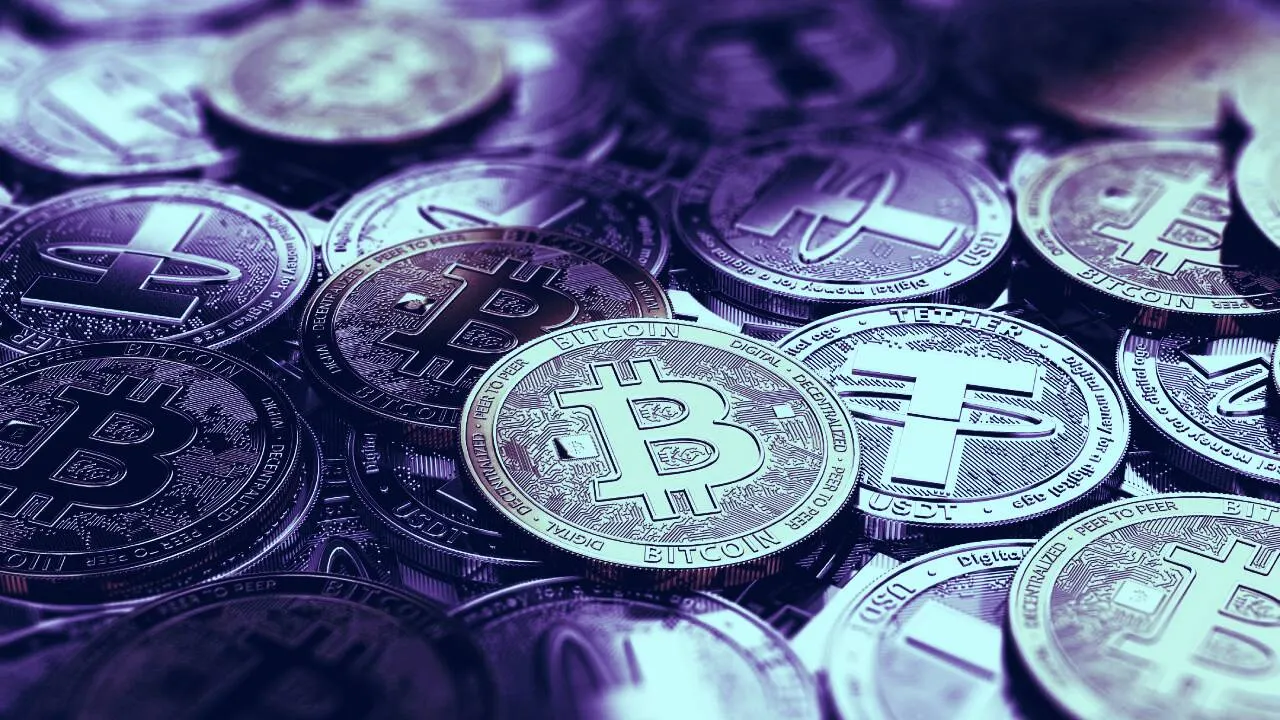In brief
- Anticipation of Bitcoin’s halving could be driving the issuance of stablecoins.
- A record $3 billion of stablecoins were deposited on exchanges this year.
- Stablecoins are increasingly being used to enable Asian trade finance.
A stablecoin boom that’s propelled their total market cap past $9.5 billion this year could signal bullish Bitcoin sentiment ahead of its imminent halving, experts told Decrypt.
According to crypto data-tracker DAppTotal, the total market cap for stablecoins topped $9.5 billion last month, with Tether (USDT), the oldest, largest, and most widely adopted stablecoin, minting over a billion dollars in April alone.
Investors “hoard” stablecoins pre-halving
Ganesh Natraj, an assistant professor of finance at Warwick Business School in the UK, told Decrypt that anticipation of Bitcoin’s halving could be driving the issuance of stablecoins.
Natraj, who recently published a paper covering stablecoins’ impact on broader crypto markets with UC Berkeley professor Richard Lyons, said that USDT issuance could be driven by “speculation on Bitcoin’s price later this year, and given the halving is due in about a month's time, investors may hoard Tether for that reason.”
“Given the halving is due in about a month's time, investors may hoard Tether for that reason.”
Lending weight to the suggestion that traders are loading up stablecoins on exchanges in preparation to buy Bitcoin, $3 billion of stablecoins were deposited on exchanges this year—a record for stablecoin reserves, according to crypto-analytics firm Messari.
There's now $3 billion++ of stablecoins sitting on exchanges.
If investors wanted to cash out of crypto completely, they would have withdrawn funds to banks.
Instead, we've got more dry powder held in the crypto economy than ever before.
In both real and market cap % terms. pic.twitter.com/rCEYNqcMY0
— Ryan Selkis (@twobitidiot) April 17, 2020
Some traders, certainly, are banking on the price of Bitcoin rising post-halving. “If the new supply of Bitcoin is cut in half, all else being equal, the price should rise,” wrote Dan Morehead, the chief executive of blockchain investment firm Pantera Capital, in his April letter to investors. Morehead notes that between the Federal Reserve’s efforts to contain the coronavirus-induced financial crisis through “unlimited” quantitative easing, and cash literally becoming a vector for the spread of disease, “there’s more than a 50-50 chance Bitcoin goes up – and goes up big.”
Do stablecoin issuances affect crypto prices?
Beyond the roughly $2.7 billion in new Tether minted in 2020, blockchain financial-compliance firm Chainalysis found a 250% increase in the amount of USDT moved on-chain, or between crypto wallets, over the last 12 months ending in March.
Much of this growth is due to transactions settled on the Ethereum (ETH) blockchain, which accounted for 90% of all USDT settlements in March. In fact, value transferred on ETH reached parity with BTC for the first time ever in April, according to Messari.
Rising dollar demand on ETH, global foreign exchange, and capital markets in general, is mirrored by growing demand for BTC.
Despite BTC’s price rocketing by over 20% in the past month though, Ganesh and Lyons found “no systematic evidence that stablecoin issuance affects cryptocurrency prices.” Their research contradicts the controversial (and disputed) view that Tether issuance serves to manipulate Bitcoin’s price, a conclusion drawn by a widely-cited 2018 University of Texas study.
Instead, they say, the opposite is true. Stablecoin issuance, Ganesh and Lyons write, “endogenously responds to deviations of the secondary market rate from the pegged rate.” In other words, stablecoin issuance responds to shifts in the crypto market, with stablecoins performing a safe-haven role in the crypto economy.
Matthew Graham, the chief executive of Sino Global Capital, a Beijing-based blockchain investment firm, agrees. “Overall, we think it’s non-trivial to predict Bitcoin prices based on stablecoin metrics,” he said. “There are correlations but these effects are swamped by other factors, such as both investor views on the halving (sentiment) and the actual reduction in the supply of new Bitcoin.”
Broadly speaking, however, Graham said he is “modestly bullish on Bitcoin’s price post-halving,” irrespective of the “non-straightforward” correlation that hyper-growth in the use of stablecoins—and their popularity as a safe haven—portend.
Stablecoins as safe havens
At the heart of stablecoins’ safe-haven narrative is dollarization. The greenback has, for the last century, served as the global reserve currency—the safest and most convertible option amongst other fiat instruments.
The ongoing economic chaos spawned by the COVID-19 pandemic has the world running for shelter in US currency. The crypto economy is no exception—hence, the flight to stablecoins.
While Tether has captured the lion’s share of stablecoin activity, competitors like the exchange-consortium-backed USD Coin (USDC), Binance USD (BUSD), and Huboi’s HUSD token are also gaining traction.
The common thread between Tether and its emerging rivals is their integration with crypto exchanges. “Proximity to liquidity matters,” Messari wrote. Another linking factor is that the three strongest stablecoins are strongly connected to Asia.
While Tether’s iFinex parent company is headquartered in Hong Kong, Binance is led by a Chinese-born chief executive and receives most of its BTC inflows from Huobi, a Singapore-based exchange founded in China. The second largest BTC flow between exchanges is just a reverse course of the leader, with around $1.2 billion moving from Binance to Huobi, according to 2019 data from crypto-tracking service TokenAnalyst.
Darius Sit, the managing partner of QCP Capital, an over-the-counter trading firm based in Singapore, says stablecoin flows have also been following this reverse current back into Asia.
Asia drives stablecoins’ ‘gain of function’
Sit told Decrypt that his firm is increasingly seeing stablecoins used to enable Asian trade finance. “Ninety percent of our spot-trading business is in stablecoins,” said Sit. “We are seeing an average of ten-to-twenty million dollars in stablecoin transaction volume every day.”
He added that businesses in Malaysia and Indonesia, for example, are using stablecoins to pay their suppliers in China, transferring funds via ETH wallets.
Chainalysis data backs this up; the firm told Decrypt that in the last month, much of the demand for Tether came from institutional traders or OTC desks, probably based in China.
While 75% of UDST/ETH transfers are less than $2,000, 65% of the value was transferred in large transactions of over $100k each. “This suggests that a large source of the demand for Tether likely comes from professionals, probably based in China, where there is no fiat available to onramp into the crypto market,” said Chainalysis spokesperson Maddie Kennedy.
Jeff Liu, the co-founder of Chinese blockchain security firm PeckShield Inc, agrees. “The majority of stablecoin users are in China and Asia, and their usage has been accelerating in recent months,” he said.
The shift is driven by “monetary mobility,” according to Sit. On the heels of the COVID-19 pandemic, companies doing business in the Asia-Pacific region encountered a banking freeze. They’ve turned to stablecoins, which, said Sit, enable more instantaneous, inexpensive, and frictionless business-to-business payments throughout Asia.
“Stablecoins are still mainly used for crypto trading and enabling capital flight,” Liu said. A 2019 PeckShield report found that crypto enabled some $11.4 billion in Chinese capital flight last year, most of which was denominated in Bitcoin and Tether. The majority of these funds moved to countries with looser capital controls like the US, Japan, and Singapore, he added.
"Stablecoins are still mainly used for crypto trading and enabling capital flight."
Despite growing stablecoin adoption in Asia, Sit believes the halving “might be a non-event.” With the block reward being further reduced, smaller miners will have less resources to compete with industrial-scale operations.
As a result, Sit said miners that priced out of the new cryptoeconomy may shut down their rigs and liquidate their holdings, exerting downward pressure on Bitcoin’s price. He also noted that “bigger miners may collude to push the price down further to accelerate the demise of smaller operations and seize more networking power.”
Regardless, stablecoins’ gain of function in Asia, combined with the first major trial of the Peoples Bank of China’s e-RMB digital currency, set to launch this week, suggests that as far as crypto goes, “the whole world is one step behind China,” said Sit.

